Opioids, justice & mercy: Courts are on the front lines of a lethal crisis
It’s not every day that a criminal defendant hugs a judge. But in courts across the country, these are unusual times.
A judicial embrace is a hard-won moment of congratulations for people with addictions graduating from the Cuyahoga County Drug Court in Cleveland. After more than a year in the diversion program—battling addictions, fighting demons and reclaiming life—hugs and tears are inevitable as participants cross a sobriety threshold most never thought possible.
“It’s been an absolute ride, this drug court,” said one new graduate. “I was always a quitter, and today I choose to be a fighter. If you have the will, you can overcome anything.”
The cycle of overdose, arrest, jail and rehab has been difficult to crack as the opioid crisis scales up and out, consuming communities. But court diversion programs such as the one helmed by Judge David Matia are expanding, and the arbiter behind the bench has increasingly become an advocate on the sidelines. Local courts are pivoting from crime and punishment to carrot-and-stick—using more humane, interventional approaches to deal with the defendants with addictions who are overwhelming their dockets.
See also: Opioid family court cases increase
This sort of crisis management is not the typical task of the judiciary, but it’s one that’s climbed courthouse steps across the country as judges nationwide have become first responders in the opioid epidemic.
“Drug court changes a judge,” says Matia, who was appointed to his position in 2008. “It changes your perspective on crime and punishment and rehabilitation. It has you question the ‘pounding the nail into the wood with a hammer’ approach we have toward criminal rehabilitation—it isn’t always effective. It changed my perspective on how I handle my criminal docket. The fulfillment of really making a difference can’t be replicated.”
Upon successful completion of drug court, graduates accept certificates; have their felony charges dismissed; thank their families, case managers and counselors; and they hug Judge Matia. It’s a proud moment for not just the graduates but also for families, friends and drug court alumni who pack the room for the March 14 ceremony.
“I was caught in the mindset of self-destruction,” one graduate said of his descent into heroin addiction, “riding a train to prison or death.” But through Cuyahoga County’s forward-thinking intervention system, he has escaped both—for now.
ADDICTION, USA
Opioid addiction in America is a dizzying array of crisis and carnage. Drug overdose is the leading cause of death for Americans under age 50, according to the New York Times. Prescription opioid painkillers have been linked to more than 200,000 deaths between 1999 and 2016, according to the Centers for Disease Control and Prevention. And the CDC reports that 115 Americans die every day, on average, from an opioid overdose. So far, six states—Alaska, Arizona, Florida, Maryland, Massachusetts and Virginia—have declared some form of public health emergency in the wake of the opioid crisis.
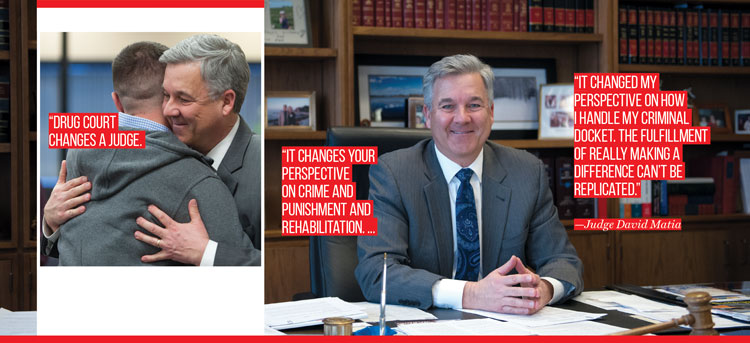
Judge David Matia: “Drug court changes a judge. It changes your perspective on crime and punishment and rehabilitation. It changed my perspective on how I handle my criminal docket. The fulfillment of really making a difference can’t be replicated.” Photographs by Rebecca Sell
Peddled by drug cartels and Big Pharma, opioids have seeped into America’s veins through street dealers, pill mills, online sellers and IV bags. Once the province of emergency rooms, prescription opioids have morphed into a drug-cabinet staple for millions of Americans. And the popularity of heroin, once widely viewed as a base and dangerous drug, has soared as its price plummeted and availability increased. Mexico and China are flooding U.S. markets with deadly synthetic opioids, and emergency responders and local governments are struggling to deal with the fallout.
“The U.S. represents 5 percent of the world’s population but 85 percent of the hydrocodone and 99 percent of the OxyContin consumed,” notes Dennis Wichern, who spent more than 30 years with the U.S. Drug Enforcement Administration before retiring in December as a special agent.
Opioid addiction is uniquely American. Other countries recognized the harm of prescription painkillers early on, with governments blocking the sale of a wide variety of opioids and other analgesics. But in many ways, courtesy of Big Pharma marketing, Americans are raised with the expectation that almost any pain—physical, psychic or emotional—can and should be escaped with a drug.
This belief was accelerated in 1996, when the American Pain Society introduced “pain as the fifth vital sign,” giving it equal status with blood pressure, heart rate, respiratory rate and temperature.
For many in the U.S., pain is not only uncomfortable—it is inconvenient. And the pharmaceutical industry has made hundreds of billions of dollars off a collective desire to transcend pain. Because pills are cheaper than other therapies, insurance companies have been on board.
Thus began campaigns to push opioids on physicians and consumers as a “safe” means to manage patient pain, whether temporary or chronic, without disclosing these pills were actually addictive.
“I get asked, ‘Why is heroin back?’ ” Wichern says. “Heroin never left. If you look at the history, people go from pills to heroin.
“We don’t need to prevent the next drug; we need to give the kids the tools and power to prevent that first dose. Just about every Drug Enforcement Administration office across America is laser-focused on heroin and fentanyl addiction to save lives.”
As black market demand for prescription pills like hydrocodone, Percocet and OxyContin has increased, these drugs have become prohibitively expensive on the street while heroin has gotten cheaper by the year. According to the DEA, in many hard-hit towns, one 30-milligram OxyContin pill can cost up to $40; a bag of heroin can go for as little as $5.
Opioids have opened the floodgates for heroin; street dealers often mix it with the cheaper—and more dangerous—painkiller fentanyl. Heroin is also sometimes mixed with carfentanil, another synthetic opioid 10,000 times more powerful than morphine. It’s a drug used to tranquilize elephants. In the hands of people with addictions, these mixtures are frequently lethal.
“Eighty percent of new heroin users start with opioids,” Wichern says, whether it’s recreational or prescribed. “Almost all heroin contains fentanyl, or it’s [pure] fentanyl on the streets. Taking heroin now, with fentanyl involved, it’s like playing with a fully loaded gun.”
BUFFALO’S BATTLE
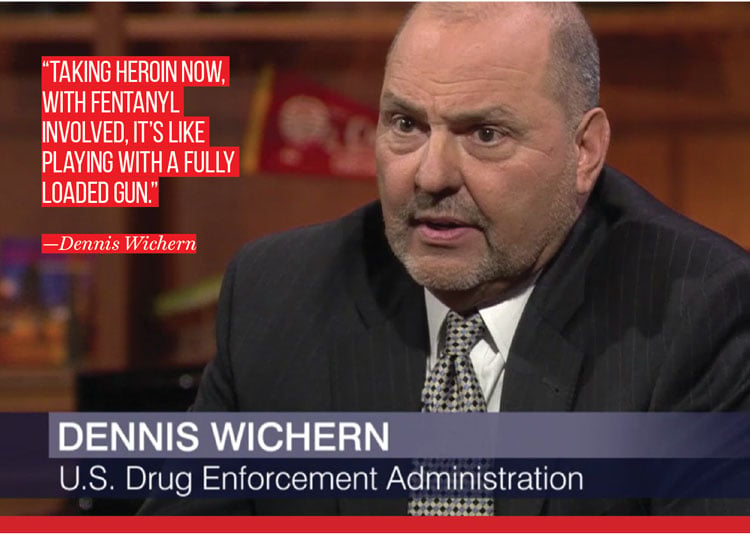
Dennis Wichern: “Taking heroin now, with fentanyl involved, it’s like playing with a fully loaded gun.” Photograph by Chicago Tonight/WTTW Channel 11
Until recently, Buffalo City Court staff meetings had a grim daily ritual: reading the obits during the morning debriefing to determine whether any of the criminal defendants had overdosed or been killed. One day in spring 2017, administrators realized a startling number of heroin defendants were dying before their next court date, and they decided something had to be done.
“We were brainstorming and thought, ‘Why don’t we start treating people at the beginning instead of the end of the case?’ ” says Judge Craig Hannah. “That approach had never been done before, but we felt we couldn’t sit idly by and not do anything.”
Administrators quickly applied for and received a $300,000 grant from the U.S. Department of Justice’s Bureau of Justice Assistance to start the nation’s first dedicated Opiate Crisis Intervention Court.
The new tribunal’s stated mission—“Our goal is to keep you alive!”—is less Law & Order, more ER. “We put their criminal case on pause while we focus on their medical case,” Hannah explains.
It’s an approach that makes sense given what the court has been tasked to do: manage victims of a drug crisis of epidemic proportions. Buffalo had an estimated 268 opioid-related drug deaths in 2017, according to the Erie County Health Department, down 11 percent from 2016, but still more than double that of previous years.
The Opiate Crisis Intervention Court is a judicially supervised triage program that links participants with medication and behavioral treatments within hours of their arrest. The goal is intervention before adjudication—and quickly.
“We are cutting the red tape, cutting the lag time, getting the medical needs addressed immediately,” Hannah adds. “The best part about this is, because it gets so much attention across the board, no one has told us no when we asked them to collaborate with us. Before you heard horror stories that it could take two to three weeks to get a bed. Six weeks to meet with a doctor who prescribes methadone. But we can find one within a day or within hours.
“I know it’s a tragedy, but sometimes tragedy brings everyone together.”
The program began May 1, 2017, intending to treat 250 people over a three-year period. So far, 215 participants have gone through the court.
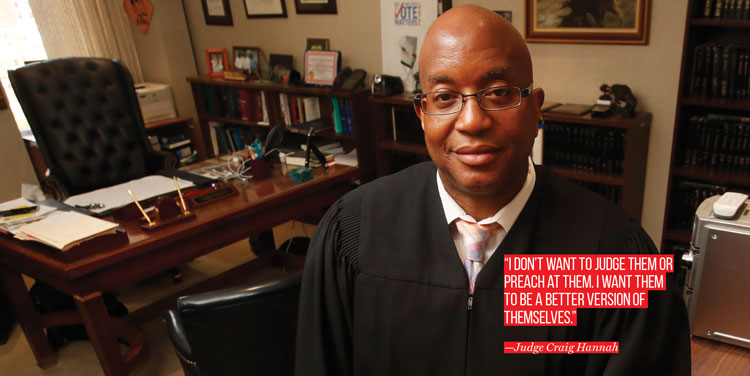
Judge Craig Hannah: “I don’t want to judge them or preach at them. I want them to be a better version of themselves.” Photograph by Sharon Cantillon/The Buffalo News
It’s a rigorously monitored program that requires detox, medically assisted treatment, 8 p.m. curfews, wellness checks, counseling and daily appearances before Hannah for at least 30 consecutive days. Some call it a “get-tough” court, but Hannah calls the approach “tough love.”
“I think the daily face-to-face time is the most important part of this,” Hannah says. “Most have burned most bridges they ever had. They’re within an inch of me, and we talk about their life, their treatment. Other people probably gave up on them, but I’m going to take them at the level they are. I don’t want to judge them or preach at them. I want them to be a better version of themselves.”
And after they get better, participants still must answer the charges that brought them to court in the first place, whether it’s theft, trespass, assault, dealing. The next step is often drug court where, depending on the severity of the case, a defendant can enter a diversion program.
The opiate court has become a model for other heroin-overwhelmed jurisdictions, and they are setting up programs to treat addiction more like a disease and less like a criminal mindset.
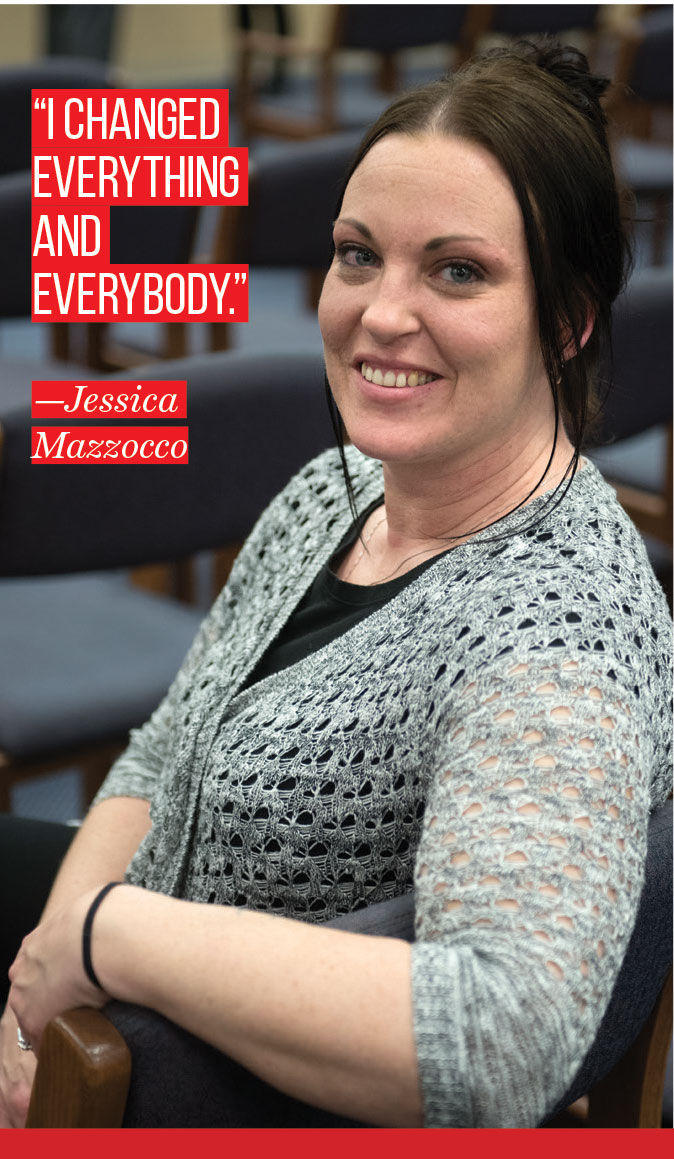
Jessica Mazzocco: “I changed everything and everybody.” Photograph by Rebecca Sell
CLEVELAND’S CHALLENGE
Jessica Mazzocco, 39, and her ex-husband were trapped in addiction for nearly a decade, and she admits to committing crimes to get money for drugs. Mazzocco overdosed four times that she can recall and was revived by emergency responders with the overdose antidote Narcan. Her ex died from a heroin overdose.
Since 2009, Mazzocco’s life has been a spiral of addiction to cocaine, pills, heroin and crack. She’s done everything for drugs: theft, prostitution, jail time. Homeless and with an outstanding warrant for possession and petty theft, in August 2016 Mazzocco turned herself in and entered the Cuyahoga County Drug Court. Nearly two years later, Mazzocco’s life is back on track: She’s engaged, has a new home, and is filing to regain custody of her kids, ages 8 and 14.
“It was like: ‘Why haven’t I started doing this before?’ It’s the best feeling ever,” Mazzocco says of the support and guidance she’s received in the diversion program. Her mindset is now focused on sobriety. “I changed everything and everybody.”
Corey Reis, 25, had a different path to addiction. He says he was first exposed to opioids at age 15 after a doctor prescribed pills when he fractured his hand. From there, he began experimenting recreationally with other drugs and heroin. Two years ago, he was arrested on St. Patrick’s Day for stealing his mother’s watch. It wasn’t the first time he caught a case. But this time, when he was released home on a personal bond, and immediately left the house to get a fix, his mother called the police. He was hauled before a judge and offered an option.
“I heard ‘less jail time,’ and I said OK,” Reis recalls of the referral to the Cuyahoga County court. “Then I got here and they acted like they cared. You can tell they wanted what was best for me when, at times, I didn’t believe in myself.”
The drug court participants have minimum biweekly appearances before Judge Matia, and they receive medication and residential treatment if needed, random drug testing and other social services. They are incentivized with rewards, including reduction of court costs and gift cards. Relapses happen, but participants are encouraged to tell the truth.
Court personnel collaborate with outside agencies and stakeholders to help people break the cycle of substance abuse and crime through daily structure, accountability and empathy. Matia says the common view of the judiciary as “umpires calling balls and strikes” fails to acknowledge the power of the courts to make a difference.
“We’re in a unique position to see what works and what doesn’t work in society,” Matia says. “When a judge calls a meeting, people show up. Courts have the moral authority, and we’re in a unique position to bring about change.”
COST AND EFFECT
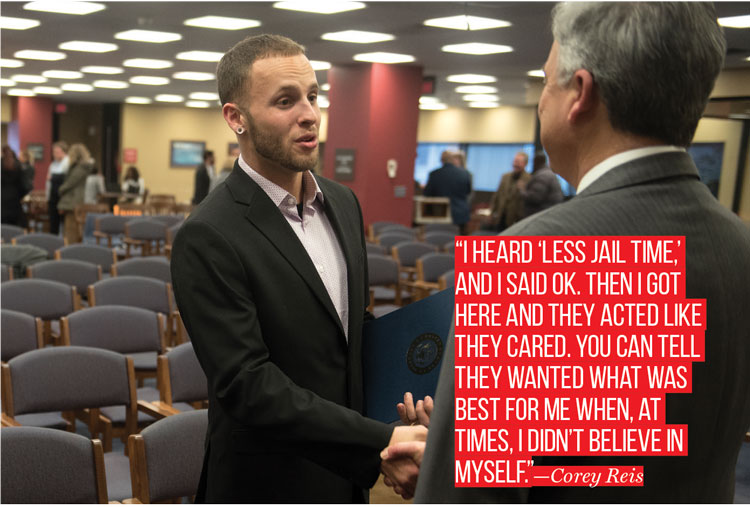
Corey Reis: “I heard ‘less jail time,’ and I said OK. Then I got here and they acted like they cared. You can tell they wanted what was best for me when, at times, I didn’t believe in myself.” Photograph by Rebecca Sell
Ohio is at the epicenter of the opioid crisis in more ways than one. The state ranks second in overdose deaths nationwide, with the number of fatal drug overdoses in 2016 surpassing 4,100, primarily from opioids, an increase of more than 36 percent from 2015. And provisional data from the National Center for Health Statistics shows Ohio had a 41 percent rise in its overdose deaths from May 2016 to May 2017.
It’s fitting then that all federal lawsuits brought by cities, counties, Native American tribes and states over the opioid crisis have been consolidated in the U.S. District Court for the Northern District of Ohio.
Judge Dan Polster is overseeing about 400 lawsuits in the multidistrict litigation and has focused on finding ways to resolve the cases this year—a herculean task by any measure. The federal MDL is in addition to countless cases filed against pharmaceutical industry players in state courts across the country.
Polster has admonished the parties to come up with a plan to resolve damages and reduce the number of pills on the street. During a Jan. 9 hearing, he acknowledged that the judicial branch was not the typical forum to lead the resolution of a national crisis.
“Ideally, this should be handled by the legislative and executive branches, our federal government and our state governments,” Polster said during proceedings for In re: National Prescription Opiate Litigation. “They haven’t seemed to have done a whole lot. So it’s here.”
Paul Hanly Jr., a New York City-based shareholder with the national law firm Simmons Hanly Conroy, serves as co-lead plaintiffs counsel on the MDL, where he represents the interest of 180 government entities. Hanly has similar lawsuits pending in state courts on behalf of dozens of counties across the U.S.
“The fact of the matter is the courts in many, many circumstances are sort of the last hope to fix a problem,” Hanly says. “And they can fix a problem because juries can send a message to corporations that will for certain change their behavior.”
Plaintiffs in the MDL allege manufacturers should never have marketed powerful opioids as safe, effective and nonaddictive drugs for the treatment of chronic pain, and that the defendants banded together to deceptively market the safety and efficacy of the drugs. Pharmaceutical companies and distributors are accused of dumping these pills in vulnerable areas of states such as West Virginia, New Hampshire and Ohio, knowing they were being abused. There are claims for failure to properly track, report and prevent the illegal distribution and use of the drugs. Suits brought by state, county and municipal governments are seeking damages for money spent on opioid treatment programs, health costs and law enforcement expenses, retroactively and prospectively.
“This is almost certainly the largest and most complex piece of litigation in the history of our country,” says Hanly. “Between 2001 and 2018, the epidemic cost $1 trillion; and by 2020, two years plus from now, if it’s unabated, it will cost another $500 billion. It’s huge, and one of the issues that has to be dealt with is where the money is going to come from.”

Purdue Pharma manufactures OxyContin. Photographs by Alamy and Shutterstock
There are dozens of defendants in the MDL, with the most prominent being Teva Pharmaceutical Ltd., Johnson & Johnson, Endo Health Solutions Inc., Allergan and the 800-pound gorilla, Purdue Pharma, maker of OxyContin. Purdue previously settled a criminal case and civil lawsuit in 2007 for $634 million after pleading guilty to a felony charge of misbranding with the intent to defraud and mislead.
Hanly represented the plaintiffs in that case. He says the verdict against Purdue turned out to be “pocket change” and a “slap on the wrist.”
“We actually were naive and kind of thought what we had gone through was an aberration and that Purdue was an outlier in terms of pharmaceutical company conduct,” Hanly says of the case. “We really didn’t see it as what it actually was: What was happening back then was the infancy of what has become a very mature epidemic.”
The opioid cases are reminiscent of the lawsuits against the tobacco industry that ended with a $246 billion settlement. But attorneys involved in the opioid litigation say that number is a drop in the bucket compared to the damages possible in the MDL. Defense teams point to a big difference in the cases that may be part of a strategy to try and mitigate damages: Tobacco inherently causes health degeneration, whereas opioids, when used appropriately, do not.
“When you have people who are illegally or improperly doing drug shopping or buying pills off the black market and abusing pills in a way they’re not supposed to, to what extent do they have culpability in their own conduct?” asks Adam Fleischer, a partner at Chicago insurance defense firm BatesCarey, which recently launched an opioid coverage task force. “The problem with this theory is how are you going to separate the wrongful conduct of the plaintiff from the wrongful conduct of the defendant?”
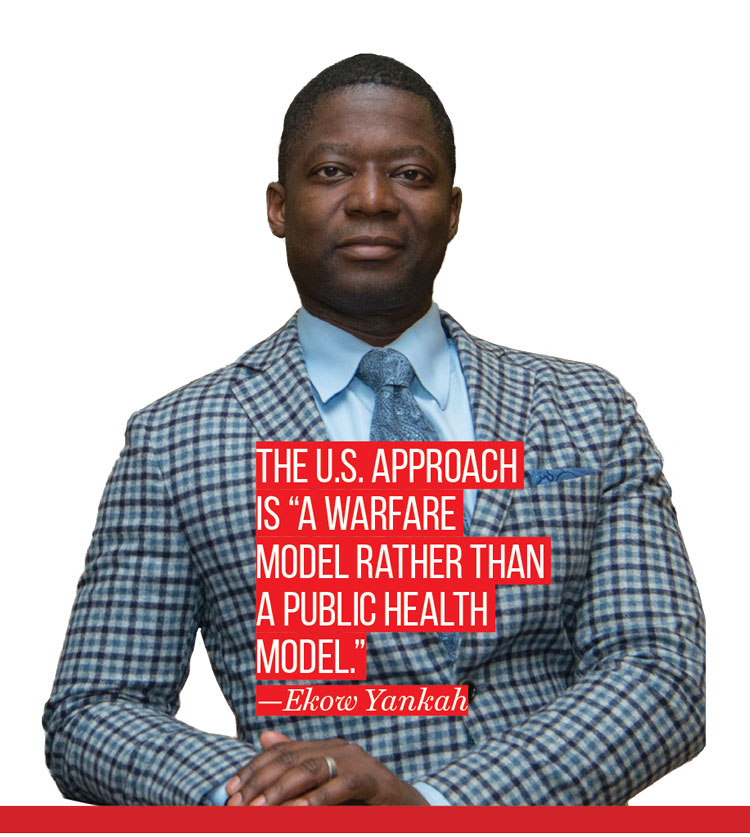
Ekow Yankah: “The U.S. approach is ‘a warfare model rather than a public health model.” Photograph by Sari Goodfriend
For the hardest-hit states and counties, there’s plenty of blame to go around, but first responders are consumed with the day-to-day management of the opioid epidemic, which has been like battling the Hydra monster. Financial resources and human capital are depleted on repeated Narcan resuscitations, treatment services, law enforcement and court costs. It’s a punishing battle on all fronts, and successes can be short-lived.
“Giving people Narcan over and over isn’t the goal,” says Kim Bailey, a professor at Chicago-Kent College of Law. “We’ve got to get away from these Band-Aid approaches; we need to get to the root level of what’s going on with these epidemics. We need to have a holistic approach that looks at economics, better schools, public health, mental health resources. But in order to do that, you need money.”
Last October, President Donald Trump declared the opioid epidemic a national emergency and vowed to “liberate our communities from the scourge of drug addiction.” He assembled a commission headed by former New Jersey Gov. Chris Christie, which issued a report with 50-plus recommendations and a dire warning that more federal money was needed.
But in the trenches, where proclamations have had very little trickle-down effect, first responders from EMTs to trial court judges have had to triage this national emergency on a daily basis, without extra support from the federal government.
And from Appalachia to Rodeo Drive, no one is untouched.
SAME LAW, DIFFERENT ORDER
Today’s heroin user has become relatable for the average American, prompting a kinder, gentler response and a sea change in how drug addiction is perceived. The terminology has morphed—these aren’t “junkies” or “addicts” but victims of a chronic illness: a substance abuse disorder. That victim could be a relative in the living room, a friend at school or even a colleague at work.
“It’s possible we’ve become more enlightened about addiction, but it probably matters who’s being affected by it,” Bailey observes.
The demographic of the current crisis is overwhelmingly white, more middle class, more empowered to change the conversation about addiction. Lobbying and agitation by parents and activists have made it easier for emergency workers, families and friends to obtain Narcan without a prescription. Police are responding differently; courts are adjudicating differently.
We have moved beyond Hillary Clinton’s fearmongering characterization of the “superpredator”—the dark-skinned threat selling crack rocks on the other side of town. The disparate treatment of the crack epidemic of the 1980s and ‘90s prompted mass incarceration, decimated communities and stigmatized drug users and their children.
Back then, the war on drugs was fought mostly in urban areas, and the public response was different: zero tolerance, harsh sentencing guidelines, militarized police. Law enforcement departments across the country received grants to purchase high-tech weapons, with money based on the number of arrests. Police were incentivized to act, with the support of many communities ravaged by the effects of drugs, poverty and violence. Now, in comparison, in many middle-class, mostly white jurisdictions such as Gloucester, Massachusetts, heroin users carrying drugs or needles can walk into a police station and be diverted to treatment instead of the lockup.
Professor Ekow Yankah of the Benjamin N. Cardozo School of Law says the changing landscape of addiction has prompted novel responses and new rhetoric. “There’s something weird if you know the joblessness rates in the African-American community, know the history, but when drug addiction hit that community, it was ‘What is wrong with our community; why are you pathological?’ ” Yankah notes. “Whereas in Rust Belt communities, it’s ‘Of course they’re turning to drugs; they don’t have any hope or ambition.’ “
“Most new heroin users are young white men with low incomes,” Wichern says. Still, no demographic has been spared, and he adds that “rates of heroin use have doubled in women.”
FEDERAL TACTICS
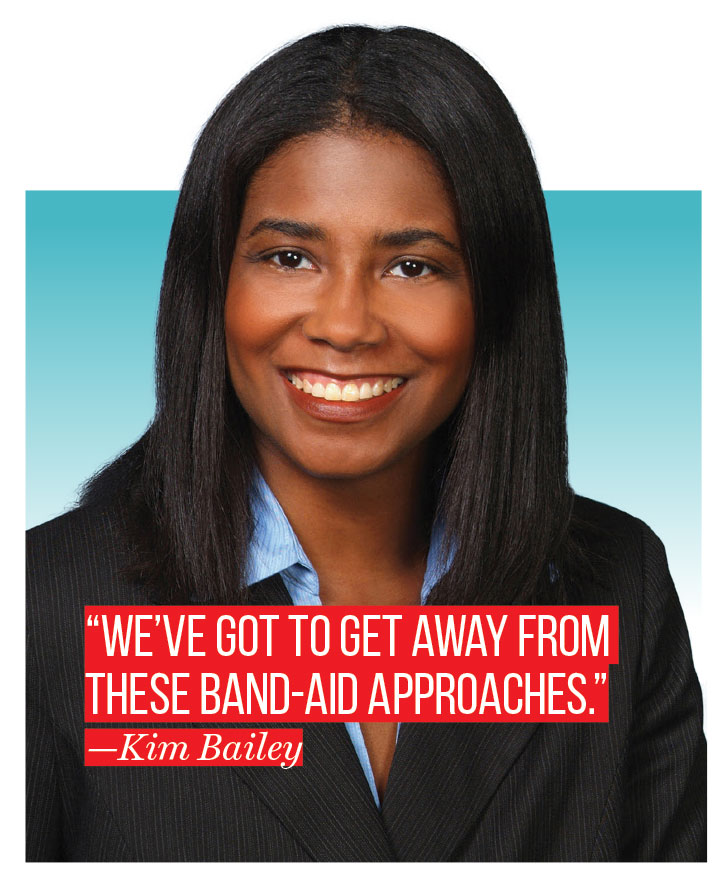
Kim Bailey: “We’ve got to get away from these Band-Aid approaches.” Photograph courtesy of Chicago-Kent College of Law
While users caught with drugs may be quickly ushered to diversion in many parts of the country, there has also been a movement to seek tougher prison sentences against drug dealers and others deemed culpable for overdose deaths, particularly at the federal level.
In a continued rollback of bipartisan sentencing reform measures, Attorney General Jeff Sessions has directed his 5,000-plus federal prosecutors to seek the harshest penalties available, reviving mandatory minimums that warehoused minority drug offenders behind bars and exploded prison populations. Sessions opposes the Sentencing Reform and Corrections Act of 2017, which would broaden judges’ ability to exercise discretion in sentencing nonviolent offenders, narrow the scope of mandatory minimum sentences to violent crimes and serious drug offenses and end juvenile life sentences without parole. The ABA supports the bill, which was re-introduced in October by Republican Sen. Chuck Grassley of Iowa.
“We’re hearing a lot of law and order rhetoric [from Sessions] like we heard during the war on drugs, but criminal justice policy has always mainly been a local issue,” Bailey notes. “I think this is an area where local governments will have to lead and the federal government will follow, instead of the reverse.”
While Sessions’ directives may be at odds with what many courts and prosecutors are doing on the ground, it’s in lockstep with administration directives. In March, President Trump offered his take on the opioid epidemic: “If we don’t get tough on the drug dealers, we are wasting our time. And that toughness includes the death penalty.”
Yankah says Trump’s statements demonstrate that some attitudes toward addiction have changed over the decades, while much has stayed the same. “You’re still stigmatized and living in a country that takes as its core response to addiction a warfare model rather than a public health model.”
Judge Matia is critical of the federal government’s response to the epidemic thus far. “There are simple things they could do, they’ve chosen not to do,” he says, such as eliminating the waiver doctors need to prescribe the opioid addiction treatment Suboxone.
Back in Buffalo, there’s nothing judgmental about Judge Hannah’s approach to addicted defendants. He tells them: I’ve been in your shoes.
“I tell everyone the only difference between you and me is time. That was Day One of their recovery, I’m in year 20. The journey starts with the first step.”
A former prosecutor who describes himself as a recovering cocaine addict, Hannah is familiar with all sides of the debate. “We locked up a generation of people and never got them the tools to succeed when they got out of jail. So they reoffended,” he says. “We had the wrong attitude toward addiction: That locking them up was making people safe. But you were locking them up and the problem was still there.”
Hannah’s goal is to meet the problem head-on and “make sure the person walks out of here a lot better than they came in.” Opiate court participants get bus passes and social services. They are linked with educational resources to complete degrees or move on to community colleges. Families are reunited; medical needs are handled. Graduates are grateful to have someone on their side: Hannah officiated at the marriage of two participants, and one asked him to be the godparent of a child.
“I tell people I don’t do legal work anymore,” he says. “I’m touching people’s lives, and I feel like this is a lot more important.”



